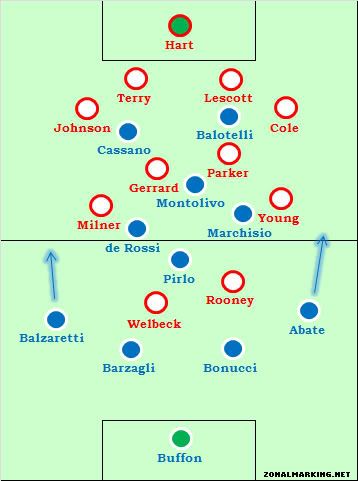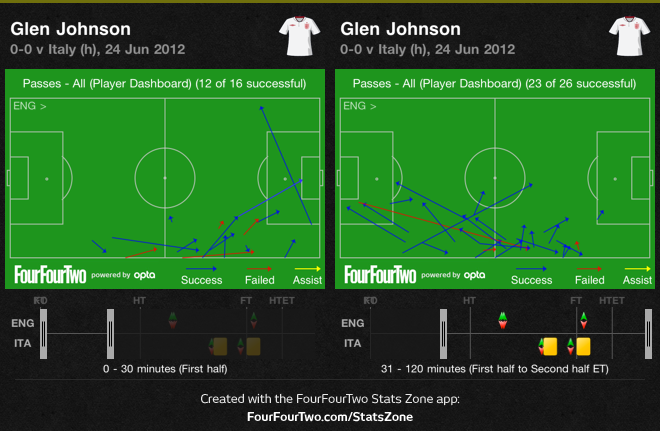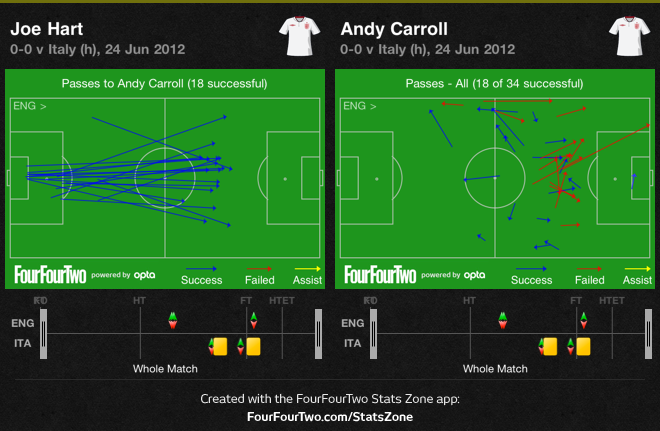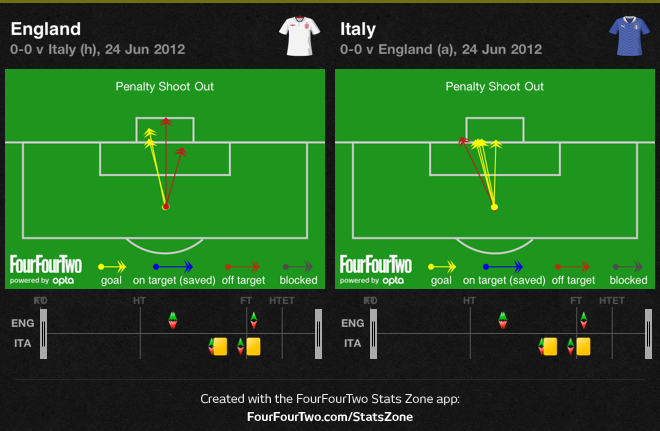|
|
本帖最后由 乔治六世 于 2012-6-28 16:02 编辑
Italy 0-0 England: Pirlo dictates the game
June 25, 2012

The starting line-ups
Italy somehow failed to score despite dominating for 120 minutes, but won the resulting penalty shoot-out.
Cesare Prandelli brought in Riccardo Montolivo to play at the top of the diamond, because of concerns over Thiago Motta’s fitness.
Roy Hodgson made no changes from the XI that narrowly defeated Ukraine in the group stage.
Italy were the better side all over the pitch here – only finishing let them down.
Tactical battle
This was a simple game – there was no progression midway through, no switch in systems, no key substitutions, no sudden change of pace. It was one system against another for two hours.
Italy’s system wanted to dominate the centre of the pitch, with two passers at either tip (Andrea Pirlo and Riccardo Montolivo) and two shuttlers along the sides providing energy and forward runs. England’s system, at least in theory, offered more width.
There were two key parts to the game – first, the width coming from full-back. Second, England allowing Pirlo to dominate the game.
Narrowness and full-backs
Italy had much more of the ball than England. This was entirely expected, whether you look at it from the point of view of systems or coaches. As a result, the formation battle was essentially on Italy’s terms, and England got dragged into a system they didn’t really want to play.
In other words, they became too narrow. James Milner was drawn inside and played close to Daniele De Rossi, while Ashley Young also ended up in a very central position near Claudio Marchisio. Milner was suited to this role and performed his defensive duties well, but Young was uncomfortable defensively and also offered little going forward. Hodgson may have been better making his side lopsided, asking Milner, Steven Gerrard and Scott Parker to deal with De Rossi, Montolivo and Marchisio, allowing Young to remain free for an out-ball on the left, to prompt counter-attacks.
As England were dragged narrow, all the width came from full-back, from both sides. England started brightly in this respect, as Glen Johnson attacked down the right and had the game’s first clear chance, when he got the ball stuck under his feet in the penalty box. He also put in a couple of good crosses, and England seemed to have the right idea when they had the ball – but after half an hour, Johnson was much more restricted in his movement.

The more the game went on, the less of the ball England enjoyed. And that meant Italy’s full-backs had much more license to get forward, stretch the play and increase the active playing zone, making England work harder to cover a large amount of ground. The Italian full-backs played significantly higher up the pitch and influenced the game more, and although they rarely provided great service into the box, they forced England back.
Pirlo
More important, however, was the freedom Andrea Pirlo enjoyed. At times England’s shape was good, bringing both strikers back into the midfield zone, remaining compact and getting both Danny Welbeck and Wayne Rooney goalside of Pirlo. When Welbeck was in a position to close down the Juventus midfielder, he generally did his job excellently.
Rooney was much sloppier, and after half an hour when Pirlo’s dominance had become clear, Joe Hart was clearly heard shouting at Rooney to pick him up. Hodgson clearly wanted Rooney to do this, because for much of the game Rooney could be seen half-heartedly jogging towards Pirlo. It was reminiscent of the 2011 Champions League final, where he started off marking Sergio Busquets, before gradually leaving Manchester United outnumbered in midfield.
It’s odd that Rooney’s tactical indiscipline has become such a problem – only a few years ago his willingness to sacrifice his own attacking game for the good of the team was reagrded as one of his main qualities. England could have done with someone like Rooney’s club teammate, Park Ji-Sung, who did a superb job on Pirlo in 2009/10 – Urby Emanuelson did something similar for Milan earlier this year. Leaving Pirlo free was suicidal, and he completed over 30 more passes than any other player.

And these weren’t just sideways balls, either – though he did help to spread the play to the full-backs. Many of them were the game’s best passes – he started off by trying to find Antonio Cassano, who was causing John Terry problems, but it soon became clear that Mario Balotelli’s pace was Italy’s main threat. One situation summed it up – Pirlo got the ball in his own area, jogged forward with the ball for 30 yards before thumping it over the top for Balotelli, who was denied by a last-ditch block from Terry. There was no pressure on Pirlo, and he subsequently created another fine chance for Cassano at the far post, who knocked the ball towards Balotelli in the six-yard box.
England never dealt with Pirlo directly, but they (presumably) inadvertently stopped him being such a threat by dropping increasingly deep. In the first half England had kept a surprisingly high line and were caught out by balls over the top, but the more Italy dominated possession, the more England were scared to leave the edge of their own penalty box.
Therefore, the space in behind had vanished, and Pirlo’s only great moment of creativity in extra-time was a similar pass to his earlier ball for Balotelli, shortly after Rooney had lost possession in the Italy box, when England were high up the pitch. But England attacked so rarely, and Italy might have benefited if England had come into the game more and left gaps at the back. England actually defended well as a unit in the final hour of the tie, with their narrowness allowing them to make plenty of blocks.
Few changes
The benches played little part in the game. Prandelli brought on Alessandro Diamanti for Cassano, Antonio Nocerino for De Rossi, and Christian Maggio for Abate. All three were influenced by fitness concerns over the departing players, and the shape of the game changed little.
Hodgson’s double substitution was slightly more about strategy, even if the formation remained the same. Theo Walcott on for Milner theoretically offered more counter-attacking ability, but Walcott never seemed to get the right pass, with Parker noticeably overhitting a couple towards him. Andy Carroll replaced Welbeck to provide more of an aerial route – this helped relieve pressure, but England rarely got players close to him.

Carroll and Walcott were the logical players to introduce, although taking off Milner and Welbeck was debatable - Milner was at least suited to the defensive challenge, while Welbeck was playing better than Rooney and would have done more to shut down Pirlo, if asked to play behind Carroll as he did commendably (albeit without attacking success) against Sweden.
Jordan Henderson replaced Scott Parker to provide energy. That made sense – Parker was exhausted, Gerrard had cramp and was sitting deep, while Henderson has previously done well as a substitute simply by providing fresh legs and mobility.
But Italy were the better side for the vast majority of the 120 minutes, and it was right that Pirlo provided the most thrilling moment in an Italian shoot-out victory.

Conclusion
Italy’s diamond controlled the game, and Pirlo was the star player – he set the tempo and created chances. England’s failure to deal with him was criminal, and Rooney’s defensive role must be questioned. Italy also dragged England narrow before attacking through the full-backs, and they really should have won the game in normal time.
We’re still waiting for Italy to produce completely convincing display – for all their dominance here, their finishing was dreadful. They’ve only scored one goal from open play in the competition, and have only beaten one side, Ireland, who had already been eliminated. Their possession play is impressive and Pirlo has been one of the competition’s star players, but they’ll surely need to be more ruthless in the final third to win the competition.
England simply weren’t good enough here, and while individual decisions can be questioned tonight (the handling of Pirlo, and the substitutions), Hodgson’s overall approach was right for the competition. When inheriting a side at such short notice, particularly a squad without great technical quality compared to either sides in the competition, it made sense to focus upon organisation and shape. The defensive performance wasn’t always impressive, but England didn’t lose a game. With more from the likes of Young and Rooney, England might have overachieved – although the non-performance of talented, creative attackers can’t be divorced from the use of a functional, defensive system. There was rarely a clear transition plan – that was evident tonight, with the wide players dragged inside and in no position to launch an attack.
For Hodgson, the real test starts now. Such a reactive style of football is entirely forgiveable for a short-term project, but England have to be in a position to play a more proactive, flexible brand of football if they want to be genuine contenders, rather than organised underdogs hoping to get lucky. |
|

